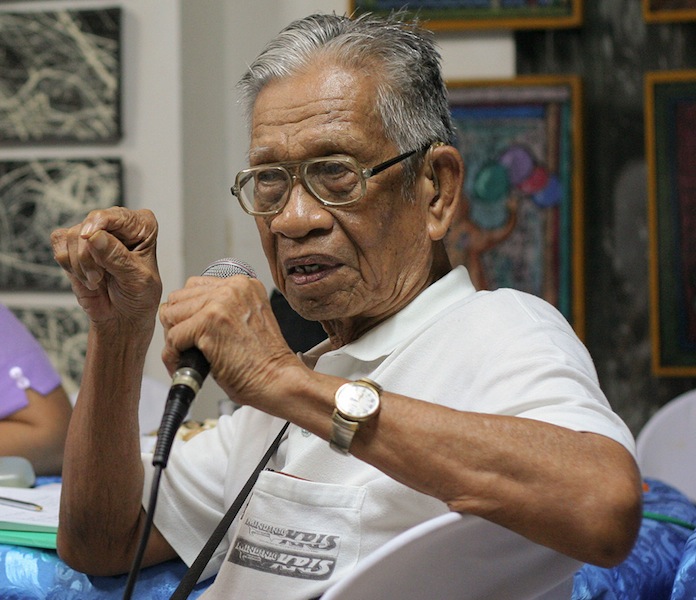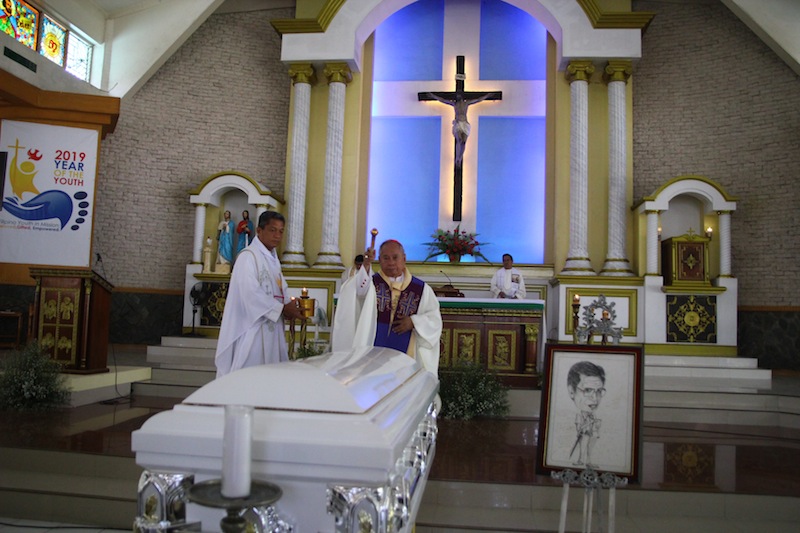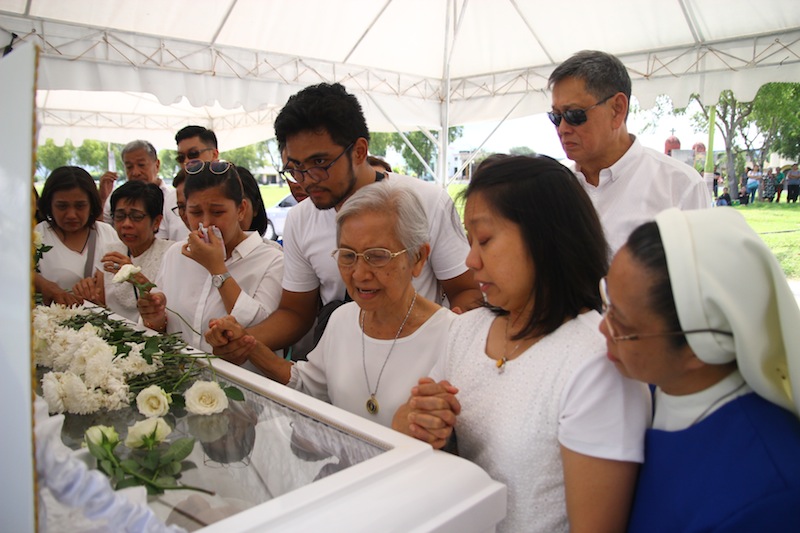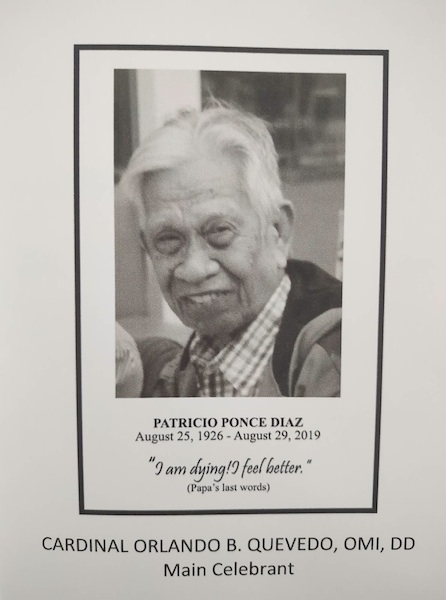GENERAL SANTOS CITY (MindaNews / 08 Sept) – Journalist Patricio Ponce Diaz, described by Cardinal Orlando Quevedo as “peacemaker” and “editor and writer extraordinaire” was laid to rest on Saturday at the Forest Lake Memorial Park, his grave shaded by a golden shower tree.
At the funeral mass at the Sts. Peter and Paul Church in Lagao, Diaz’ parish, the Cardinal focused on the 93-year “peacemaker” and likened him to Jesus: “he’s like Jesus. A man of peace, a man of non-violence.”
 Patricio P. Diaz stresses a point during a MindaNews meeting on 15 September 2007 in Davao City. MindaNews photo by BOBBY TIMONERA
Patricio P. Diaz stresses a point during a MindaNews meeting on 15 September 2007 in Davao City. MindaNews photo by BOBBY TIMONERA
“He didn’t’ have to go out and negotiate for peace. He just simply wrote down the history of the Bangsamoro struggle for self-determination, the history of governments and how they addressed self-determination. A man of peace,” Quevedo of the Oblates of Mary Immaculate (OMI), said at the mass where he was the main celebrant.
Fr. Charlie Inzon, OMI Provincial Superior, Fr. Rogelio Tabuada, OMI, Chief Executive Officer of the Notre Dame Broadcasting Corporation, and parish priest Fr. Ronald Piomillo, DCM, concelebrated the mass with him.
Diaz passed away on August 29 at the St. Elizabeth Hospital in General Santos City.
He was rushed to the hospital as he was preparing to leave for mass to celebrate his 93rd birthday on August 25. Quevedo was the presider of that mass. He later proceeded to the hospital to give his blessings to Diaz.
“How is Pat a peacemaker? For me he was the (most important) secondary source of the aspirations of the Moro people for self determination and freedom. He made several books that chronicled that history, the revolution … He raised questions. he educated the Christians about those issues,” Quevedo said.
As a journalist, Diaz had followed the Bangsamoro struggle from 1952 to 2019, the lone Mindanawon journalist with the longest institutional memory on the complex issue.
 Cardinal Orlando Quevedo, OMI, Archbishop Emeritus of Cotabato City, blesses the casket of his friend, Patricio Ponce Diaz, at the Sts. Peter and Paul Church in Lagao, General Santos City on 07 September 2019. Quevedo described Diaz as “peacemaker,” and “editor and writer extraordinaire.” MIndaNews photo by GREGORIO BUENO
Cardinal Orlando Quevedo, OMI, Archbishop Emeritus of Cotabato City, blesses the casket of his friend, Patricio Ponce Diaz, at the Sts. Peter and Paul Church in Lagao, General Santos City on 07 September 2019. Quevedo described Diaz as “peacemaker,” and “editor and writer extraordinaire.” MIndaNews photo by GREGORIO BUENO
Quevedo said the peace panels of government and the Moro liberation groups “read his chronicles on the self-determination aspiration” of the Moro.
“It is his writings that make him a peacemaker,” he said.
He recalled the “commentaries almost every week (that Diaz) submitted to MindaNews. In depth. Analyses that are profound. Indeed a man of peace. He’s like Jesus. A man of peace. A man of non-violence.”
He said the beatitude for Diaz is “Blessed are the peacemakers for they will be called children of God.”
Quevedo also recalled how Diaz mentored thousands of students at the Notre Dame University in General Santos City where he taught English and literature. “many of whom became celebrities like (Cotabato) Archbishop Angelito Lampon.”
“I am dying! I feel better”
Diaz’ last words on August 29 were “I am dying!” and “I feel better.”
He breathed his last at 6:20 p.m.
 The family of Patricio Ponce Diaz led by wife Lucy, bids him farewell at the Forest Lake Memorial Park in General Santos City on 07 September 2019. MindaNews photo by GREGORIO BUENO
The family of Patricio Ponce Diaz led by wife Lucy, bids him farewell at the Forest Lake Memorial Park in General Santos City on 07 September 2019. MindaNews photo by GREGORIO BUENO
Quevedo said some may interpret Diaz’ last words to mean “now all my pain will end” but it was more of “I am now going to my father’s home and therefore I feel better.”
From the church, the Cardinal proceeded to the Forest Lake Memorial Park to give the final blessings.
Mohagher Iqbal, chair of the Moro Islamic Liberation Front’s (MILF) peace implementing panel and Minister for Education in the Bangsamoro Autonomous Region in Muslim Mindanao (BARMM), said he will miss “one of the few Christian writers in Mindanao who wrote objectively about the conflict in this region.”
“For biased readers, he was viewed as pro-Moro … (but) he was simply writing what truthfully is to be narrated.”
“My utmost and sincerest condolence to his family and relatives,” said Iqbal.
Datu Michael Mastura, former Congressman and senior member of the MILF panel that negotiated the peace agreement, said he feels sad about Diaz’ death.
“I feel sad. Pat, a close family friend, has passed away. God, what an insightful mind,” he told MindaNews.
Lawyer Zainudin Malang, former Executive Director of the now defunct Mindanao Human Rights Action Center, described Diaz as “the original chronicler of the peace process.”
“The man who helped us understand it has left us. Rest in peace, Manong Pat,” Malang said.
Patricia Sarenas of the Mindanao Coalition of Development NGO, wrote: “Salute to one of our Mindanao heroes! We will miss you and your thought-provoking but always truthful articles about Mindanao, Sir Pat. For the CSOs in Mindanao who had the privilege of reading your articles or of listening to you, a part of you shall live forever in our hearts! Daghan salamat for your selfless and courageous sharing of your wisdom! Godspeed, Sir Pat!”
“He is/was Mindanao’s treasure. My salute, Sir Pat,” artist and writer Ramon Jorge Sarabosing of Butuan City wrote.
Decommissioning
As reporter, columnist and editor, Diaz followed the Bangsamoro struggle, chronicled the stirrings of the revolution, the communal violence in the Ilaga-Barracuda era, the Jabidah Massacre, the founding of the Mindanao Independence Movement and later the Moro National Liberation Front and Moro Islamic Liberation Front and the peace processes that led to the signing of peace agreements, the implementation or failed implementation, and on his last year, the birth of the Bangsamoro Autonomous Region in Muslim Mindanao.
On the day of his interment on September 7, the first 30% of the MILF’s combatants and weapons were decommissioned in Simuay, Sultan Kudarat, Maguindanao.
Teacher, Journalist
While teaching English and Literature at the Notre Dame University, Diaz wrote for The Mindanao Cross as columnist and reporter, editorial writer-on-call from 1952 to 1967 and was its editor in chief for 21 years — from 1968 to 1989. He also edited and published Mindanao Kris from 1989 to 1996, wrote columns for Mindanao Trend in Cotabato City from 1996 to 2000 and SunStar General Santos from 2000 to 2001, and wrote “Comment” for MindaNews since its birth in 2001. He wrote short pieces under ‘Mind Da News” and “To the Point.”
 Patricio Ponce Diaz.. 25 August 1926 – 29 August 2019.
Patricio Ponce Diaz.. 25 August 1926 – 29 August 2019.
Diaz’s first book, “To Tripoli and Back,” was published in Cotabato City in 1995 and “What Ails Muslim Autonomy?” published in General Santos City in 1998.
MindaNews published three of his books: Understanding Mindanao Conflict in 2003; “The 2010 GRP-MILF Peace Drafts: With Comments and Analysis” in 2010 with Mindanao historian Rudy Buhay Rodil; and “Troubled Odyssey,” also on the Bangsamoro peace process, in 2011.
Diaz is survived by wife Lucy, his children — Maria Lourdes D. Johanson, Patricio Alfonso Jr., Sister Maria Teresa, OND; Tirso Eduardo, Maria Margarita, Ana Maria Victoria, Maria Dolores D. Lo, Ma. Carmela D. Arellano, and Frances Elizabeth – four grandchildren and a great granddaughter. (Carolyn O. Arguillas / MindaNews)
